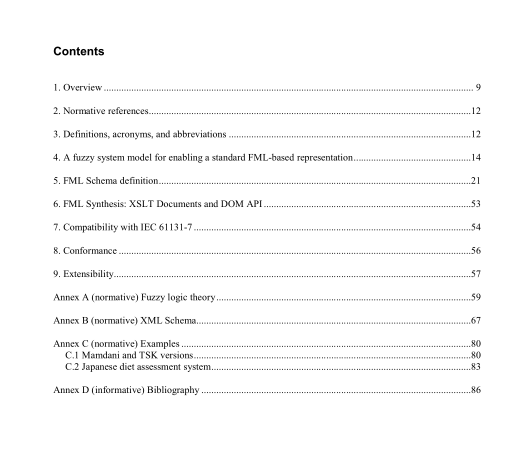IEEE 1855-2016 pdf download.IEEE Standard for Fuzzy Markup Language.
This standard defines an eXtensible Markup Language (XML)-based language, named Fuzzy Markup Language (FML), aimed at providing a unified and well-defined representation of Fuzzy Logic Systems (FLSs). This standard includes an extendable schema that natively defines the basic components of an FLS and enables the modeling of different categories of fuzzy inference engines, including Mamdani [B16], Tsukamoto [B21], Takagi-Sugeno-Kang (TSK) [B20], and AnYa [B5].
1.2 Purpose
The purpose of this standard is to allow the creation of interoperable FLSs. This standard uses the W3C XML Schema definition (XSD) language as the encoder, which allows for interoperability and the exchange of XML-based FLS instances between various systems. Different from other approaches used to describe fuzzy systems such as Fuzzy Control Language (FCL), FML allows fuzzy designers to simply code their ideas on heterogeneous hardware without need for a deep understanding of details related to the different platforms. This approach enables fuzzy systems designers to achieve design transparency. It means that, by using FML, it is possible to implement the same FLS on different hardware architectures with minimal effort and without additional design and implementation steps. In short, FML makes it possible to model an FLS in a human-readable and hardware-independent way.
1.3 The importance of the design of interoperable programmable controllers
The quality of design and maintenance steps of a generic industrial product strongly depends on the product documentation, e.g., written specifications, schematic diagrams, mechanical assembly drawings, and so on [B7]. If the documentation is correct and detailed, it is possible to transfer manufacturing of a product from one company to another just by transferring a complete and correct set of the applicable documentation [B7]. Different industrial standards define the required documentation for products belonging to different technological and industrial domains [B7]. For complex systems, there are families of standards encompassing all aspects of a product [B7]. For instance, the IEC 61131 family of standards on “Programmable Controllers” consists, at the time of this writing, of eight standards documents [B7]:
Part 1: General information
Part 2: Equipment requirements and tests
Part 3: Programming languages
Part 4: User guidelines
Part 5: Messaging service specification
Part 6: Communications via fieldbus (awaiting completion of fieldbus standards)
Part 7: Fuzzy control programming
Part 8: Guidelines for the application and implementation of programming languages
Part 7 is extremely important as it covers actual algorithms that power the programmable controllers [B7]. The nature of fuzzy logic (FL) is such that, without good and standardized documentation, it is impossible to understand how the control algorithm works [B7]. Part 7, Fuzzy control programming, has the explicit objective stated in the document: to provide the designers of fuzzy systems with a unified and common understanding of the basic means to integrate fuzzy reasoning in the Programmable Controller languages according to IEC 61131-3, as well as the possibility to exchange interoperable fuzzy control programs among different hardware architecture [B7]. The first goal, i.e., the one related to the programming languages, is probably less relevant today than the standards committee thought [B7]. In fact, IEC 61131-3 defines three graphical and two textual programming language standards for PLC (i.e., Programmable Logic Controller) [B7]:
Ladder diagram (LD), graphical
Function block diagram (FBD), graphical
Structured text (ST), textual
Instruction list (IL), textual
Sequential function chart (SFC), graphical
This is clearly restrictive and reflects both the date of publication of the standard, December 1993, and the fact that it had been under revision for quite some time. Today, the object-oriented paradigm would probably be added [B7]. The second goal, i.e., the possibility to exchange interoperable fuzzy control programs among different hardware architectures, has become very relevant to practitioners and vendors of software for fuzzy systems, not only in the area of fuzzy control, but also in the more general area of FL applications [B7]. In many applications, fuzzy systems have useful benefits when compared to traditional controllers (see Annex A). However, the actual design of fuzzy systems heavily relies on hardware architectures, which will implement the running version of planned controllers. Indeed, even though fuzzy systems can be developed by using hardware solutions characterized by low costs and low complexity, their implementation is strongly bounded by the electrical, electronic, and programming constraints related to the particular hardware platform [B1]. IEEE 1855 pdf download.IEEE 1855-2016 pdf download
IEEE 1855-2016 pdf download

Leave a Reply